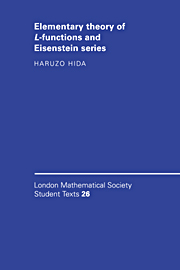Book contents
- Frontmatter
- Contents
- Preface
- Suggestions to the reader
- Chapter 1 Algebraic number theory
- Chapter 2 Classical L-functions and Eisenstein series
- Chapter 3 p-adic Hecke L-functions
- Chapter 4 Homological interpretation
- Chapter 5 Elliptic modular forms and their L-functions
- Chapter 6 Modular forms and cohomology groups
- Chapter 7 Ordinary Λ-adic forms, two variable p-adic Rankin products and Galois representations
- Chapter 8 Functional equations of Hecke L-functions
- Chapter 9 Adelic Eisenstein series and Rankin products
- Chapter 10 Three variable p-adic Rankin products
- Appendix Summary of homology and cohomology theory
- References
- Answers to selected exercises
- Index
Chapter 4 - Homological interpretation
Published online by Cambridge University Press: 12 April 2010
- Frontmatter
- Contents
- Preface
- Suggestions to the reader
- Chapter 1 Algebraic number theory
- Chapter 2 Classical L-functions and Eisenstein series
- Chapter 3 p-adic Hecke L-functions
- Chapter 4 Homological interpretation
- Chapter 5 Elliptic modular forms and their L-functions
- Chapter 6 Modular forms and cohomology groups
- Chapter 7 Ordinary Λ-adic forms, two variable p-adic Rankin products and Galois representations
- Chapter 8 Functional equations of Hecke L-functions
- Chapter 9 Adelic Eisenstein series and Rankin products
- Chapter 10 Three variable p-adic Rankin products
- Appendix Summary of homology and cohomology theory
- References
- Answers to selected exercises
- Index
Summary
In this chapter, we will give a homological interpretation of the theory of the special values of Dirichlet L-functions over Q and will reconstruct p-adic Dirichlet L-functions by a homological method (called the “modular symbol” method). A similar theory might exist for arbitrary fields, but here we restrict ourselves to Q. The modular symbol method was introduced by Mazur [MzS] in the context of modular forms on GL(2) as we will construct later, in §6.5, p-adic L-functions of modular forms (on GL(2)) by his original method. Basic facts from cohomology theory we use in this section are summarized in Appendix at the end of this book. We use standard notations for cohomology groups introduced in Appendix without further warning and quote, for example, Theorem 1 in the appendix as Theorem A.1. If the reader is not familiar with cohomology theory, it is better to have a look at Appendix before reading this chapter.
Cohomology groups on Gm(C)
We consider the space T = C/Z, which is isomorphic to Gm(C) via z ↦ e(z) = exp(2πiz). Thus T ≅ P1(C)-{0.∞}, where P1(C) is the projective line. We apply the theory developed in Appendix to X = P1(C) and Y = T. With the notation of Proposition A.5, S is first {0,∞} and later will be μN∪{0,∞}, and So will be {0,∞}. We have π1(T) ≅ Z. Let A be any commutative algebra.
- Type
- Chapter
- Information
- Elementary Theory of L-functions and Eisenstein Series , pp. 107 - 124Publisher: Cambridge University PressPrint publication year: 1993



